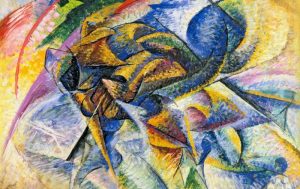Suprematism
Suprematism was one of the many artistic movements that emerged in the years surrounding World War I and that sought to contextualize abstract art according to its capacity as a means of trying to help humanity to find a more meaningful existence. It can be considered spiritual, idealistic, or utopian art; whatever label we attribute to it, the aim of Suprematism was to seek different ways of using abstraction to free oneself from the expectations and limitations of the physical world and connect with something purer.
What is suprematism?
Suprematism is an art movement that developed alongside constructivism which encourages a love of geometric abstraction and non-figurative art to represent a visual universe filled with pure geometric figures.
Understanding suprematism
Suprematism consists of promoting a taste for geometric abstraction and non-figurative art. It consists in representing the visual universe full of pure geometric forms, it looks for the way to remake the conventional art looking for geometric sensibility reaching a pure, simple and insurmountable abstractionism. The suprematism can be manifested in three different phases:
- The first phase was known as the black phase, because in it, all the images present black forms painted on a white background.
- The second phase added other colors in the works, mainly red. Through an enlarged color palette, it played with dimensionality and perception, producing confusion between rationality and reality.
- The final phase of Suprematism was the white phase, and it was white forms painted on white backgrounds.
Characteristics of suprematism
The main characteristics of suprematism are the following:
- This type of painting disassociated itself from nature and gives rise to a totally original reality.
- The outside world was not useful to the artist.
- It had supremacy in the plastic sensibility before any materialistic, practical, social, descriptive or illusory end.
- It was an art with form abstraction because only triangles, squares, crosses and circles were used.
- Its forms were pure and absolute with simple harmonies.
- Contrasting flat colors were used, mainly primary colors and some intermediate ranges, white and black.
- The range of colors was quite small and mainly used the color red, black, blue, white and green.
- It had a strong predominance of neutral backgrounds, generally white.
- The paintings provided a sensation of movement and speed.
History
In 1913, a Russian painter named Kazimir Malevich discovered while working on a project, that he felt a special connection between basic geometric forms and his own inner sense of purity. Trained as a realistic painter, Malevich had tended to make art that represented the physical world. But as many others of his time, he was in conflict over the relevance of a representative art to a changing world.
Malevich experimented with sketches of simple geometric shapes and began to write about their aesthetic value. He developed a theory that states that art suitable for modernity must attempt to communicate through a purely abstract visual language based on simple geometric forms. He believed that this type of language could transcend rationality and reach the visual equivalent of the perfect zero: total aesthetic purity. Malevich called his new approach to painting suprematism.
Malevich first exhibited his suprematism paintings in 1915 in Petrograd, in a show called The Last Futuristic Painting Exhibition 0.10. The origin of the program’s title was a reference to the idea that the old world was ending (hence the zero) and that there were originally ten artists in the exhibition, although 14 artists were eventually included.
Paint
Painting is based on color and shape. Color, which is obtained through painting, is applicable to all geometric planes. In the paintings, the vanishing point is not on the horizon, but on the infinite. Geometric shapes are made on white canvas and light waves in space move at different speeds and can be captured in different ways. When the planes are placed vertically or horizontally, the composition is static, and if they are structured diagonally it is dynamic. The static and dynamic, highlighted by color and form, established the content of suprematism painting.
Sculpture
Sculpture also promoted geometric abstraction and non-figurative art in order to achieve the supremacy of nothingness and to represent the universe without objects. Suprematism rejected conventional art and sought sensitivity through geometric abstraction.
Architecture
As for architecture, suprematism completely rejects the use of conventional art and is based on the beginning of a search for pure sensitivity within the area of geometry to achieve an abstraction of very simple shapes and colors.
Importance
Its importance lies in the fact that it allows the human being to establish a connection with his inner self in a direct way because there is no obligation or force that obliges him to represent something that already exists but something that emerges purely and completely from within.
Representatives of suprematism
The main representatives of suprematism are:
- Kazimir Malévich, Russian, 1879 – 1935
- Aleksandra Ekster, Russian, 1882 – 1949
- Olga Rozanova, Russian, 1886 – 1918
- El Lisitski, Russian, 1890 – 1941
- Alexander Rodchenko, 1891-1956
Works
Among the most representative works of suprematism we can mention the following:
- Landscape with yellow house
- On the boulevard
- Apple tree in flower
- Relax, society with top hats
- Knife Sharpener
- An Englishman in Moscow
- Partial eclipse with the Mona Lisa
How to cite this article?
Briceño V., Gabriela. (2019). Suprematism. Recovered on 23 February, 2024, de Euston96: https://www.euston96.com/en/suprematism/










